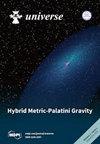Non-Canonical Dark Energy Parameter Evolution in a Canonical Quintessence Cosmology
IF 2.5
4区 物理与天体物理
Q2 ASTRONOMY & ASTROPHYSICS
引用次数: 0
Abstract
This study considers the specific case of a flat, minimally coupled to gravity, quintessence cosmology with a dark energy quartic polynomial potential that has the same mathematical form as the Higgs potential. Previous work on this case determined that the scalar field is given by a simple expression of the Lambert W function in terms of the easily observable scale factor. This expression provides analytic equations for the evolution of cosmological dark energy parameters as a function of the scale factor for all points on the Lambert W function principal branch. The Lambert W function is zero at a scale factor of zero that marks the big bang. The evolutionary equations beyond the big bang describe a canonical universe that is similar to ΛCDM, making it an excellent dynamical template to compare with observational data. The portion of the W function principal before the big bang extends to the infinite pre-bang past. It describes a noncanonical universe with an initially very low mass density that contracts by rolling down the dark energy potential to a singularity, big bang, at the scale factor zero point. This provides a natural origin for the big bang. It also raises the possibility that the universe existed before the big bang and is far older, and that it was once far larger than its current size. The recent increasing interest in the possibility of a dynamical universe instead of ΛCDM makes the exploration of the nature of such universes particularly relevant.经典五元宇宙学中的非经典暗能量参数演化
本研究考虑的是平坦、与引力耦合最小、具有暗能量四元多项式势的五元宇宙学的具体情况,其数学形式与希格斯势相同。以前关于这种情况的研究确定,标量场是由易于观测的尺度因子的朗伯 W 函数的简单表达式给出的。这个表达式为宇宙学暗能量参数的演化提供了解析方程,它是兰伯特 W 函数主支上所有点的尺度因子的函数。兰伯特 W 函数在大爆炸的尺度因子为零时为零。大爆炸之后的演化方程描述了一个与ΛCDM 相似的典型宇宙,使其成为与观测数据进行比较的绝佳动力学模板。大爆炸之前的 W 函数本构部分一直延伸到大爆炸之前的无限过去。它描述了一个非正则宇宙,其初始质量密度非常低,通过暗能量势能向下滚动收缩,在尺度因子零点形成奇点,即大爆炸。这为大爆炸提供了一个自然起源。这也提出了一种可能性,即宇宙在大爆炸之前就已经存在,而且要古老得多,它曾经比现在的大小要大得多。最近,人们越来越关注用动力学宇宙代替ΛCDM的可能性,这使得探索这种宇宙的性质变得尤为重要。
本文章由计算机程序翻译,如有差异,请以英文原文为准。
求助全文
约1分钟内获得全文
求助全文
来源期刊

Universe
Physics and Astronomy-General Physics and Astronomy
CiteScore
4.30
自引率
17.20%
发文量
562
审稿时长
24.38 days
期刊介绍:
Universe (ISSN 2218-1997) is an international peer-reviewed open access journal focused on fundamental principles in physics. It publishes reviews, research papers, communications, conference reports and short notes. Our aim is to encourage scientists to publish their research results in as much detail as possible. There is no restriction on the length of the papers.
 求助内容:
求助内容: 应助结果提醒方式:
应助结果提醒方式:


